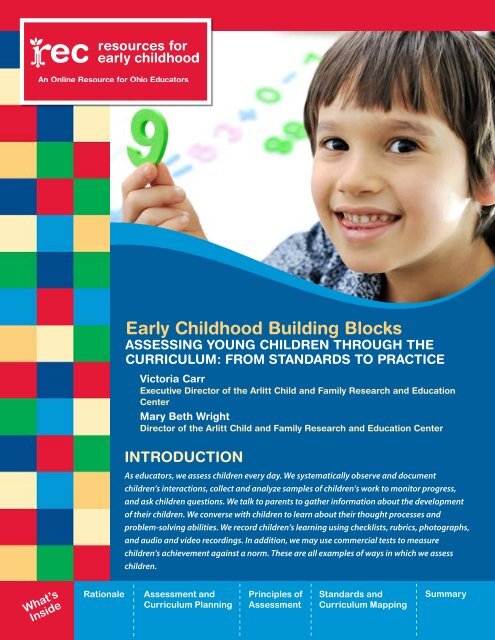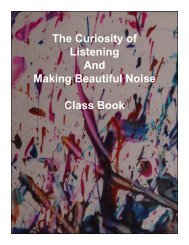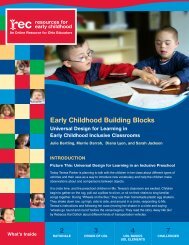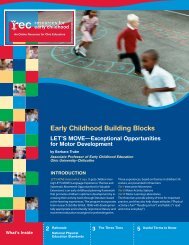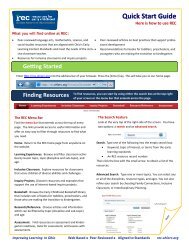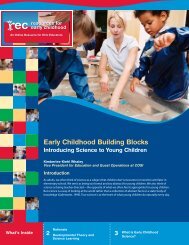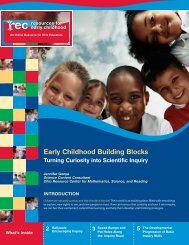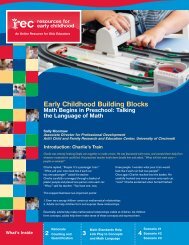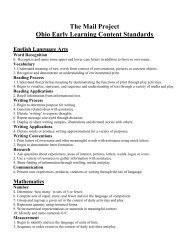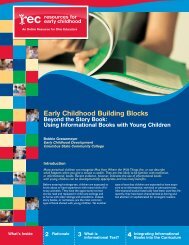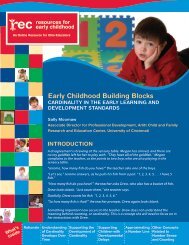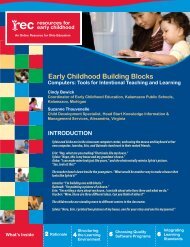Assessing Young Children Through the Curriculum: From Standards
Assessing Young Children Through the Curriculum: From Standards
Assessing Young Children Through the Curriculum: From Standards
You also want an ePaper? Increase the reach of your titles
YUMPU automatically turns print PDFs into web optimized ePapers that Google loves.
Rationale Assessment and Principles of <strong>Standards</strong> and Summary<br />
<strong>Curriculum</strong> Planning Assessment <strong>Curriculum</strong> Mapping<br />
Early Childhood Building Blocks : <strong>Assessing</strong> <strong>Young</strong> <strong>Children</strong> <strong>Through</strong> <strong>the</strong> <strong>Curriculum</strong>: <strong>From</strong> <strong>Standards</strong> to Practice<br />
What’s<br />
Inside<br />
early Childhood Building Blocks<br />
<strong>Assessing</strong> <strong>Young</strong> <strong>Children</strong> <strong>Through</strong> The<br />
CurriCulum: <strong>From</strong> sTAndArds To PrACTiCe<br />
Victoria Carr<br />
executive director of <strong>the</strong> Arlitt Child and Family research and education<br />
Center<br />
mary Beth Wright<br />
director of <strong>the</strong> Arlitt Child and Family research and education Center<br />
inTroduCTion<br />
As educators, we assess children every day. We systematically observe and document<br />
children’s interactions, collect and analyze samples of children’s work to monitor progress,<br />
and ask children questions. We talk to parents to ga<strong>the</strong>r information about <strong>the</strong> development<br />
of <strong>the</strong>ir children. We converse with children to learn about <strong>the</strong>ir thought processes and<br />
problem-solving abilities. We record children’s learning using checklists, rubrics, photographs,<br />
and audio and video recordings. In addition, we may use commercial tests to measure<br />
children’s achievement against a norm. These are all examples of ways in which we assess<br />
children.<br />
1
ATionAle<br />
Assessment can be defined as all <strong>the</strong> processes used to collect information about a child (Wolery, 1994). The data<br />
collected are organized, interpreted, and used to make decisions about curriculum and instruction. This is<br />
<strong>the</strong> essential purpose of assessing children in early childhood classrooms: to answer questions and make decisions<br />
about children’s learning and development and to identify ways to help <strong>the</strong>m move forward.<br />
With <strong>the</strong> current emphasis on standards in early childhood education (see Ohio Early Learning and<br />
Development <strong>Standards</strong> Birth to Age 5), it is important that <strong>the</strong> classroom curriculum align with <strong>the</strong><br />
standards. Many educators also feel that <strong>the</strong> standards can and should be a foundational support for<br />
assessing children. The introduction to <strong>the</strong> Ohio Early Learning and Development <strong>Standards</strong> (2012) explains<br />
that:<br />
Teachers and o<strong>the</strong>rs can use <strong>the</strong> standards as starting<br />
points for observing and understanding young<br />
children’s learning and development. With each<br />
learning encounter teachers observe, <strong>the</strong>y can<br />
refer to <strong>the</strong> standards and ask what knowledge<br />
and skills are <strong>the</strong> children gaining in <strong>the</strong> areas of<br />
language and literacy, cognition and general knowledge,<br />
social and emotional development, physical well-being<br />
and motor development, and approaches toward learning.<br />
Teachers can use <strong>the</strong>ir observations of integrated learning<br />
to plan new learning encounters for young children and<br />
support <strong>the</strong> building of knowledge in all essential<br />
domains of school readiness. (p. 5)<br />
If both <strong>the</strong> curriculum and assessments are grounded in <strong>the</strong> standards, <strong>the</strong> curriculum can be <strong>the</strong> basis for<br />
monitoring and assessing children’s learning and development.<br />
AssessmenT And CurriCulum PlAnning<br />
Since <strong>the</strong> curriculum needs to be aligned to <strong>the</strong> standards and since assessments are aligned to <strong>the</strong><br />
curriculum, we know <strong>the</strong> assessments will be aligned to <strong>the</strong> standards, too. These assessments must be<br />
sensitive enough to document each child’s progress through <strong>the</strong> curriculum. Used on an ongoing basis,<br />
through both formal and informal means, aligned assessments create a more complete picture of <strong>the</strong> child<br />
and <strong>the</strong> educational process. They also give educators <strong>the</strong> necessary information to make informed decisions<br />
on how to plan and integrate learning experiences for children.<br />
Early Childhood Building Blocks : <strong>Assessing</strong> <strong>Young</strong> <strong>Children</strong> <strong>Through</strong> <strong>the</strong> <strong>Curriculum</strong>: <strong>From</strong> <strong>Standards</strong> to Practice<br />
2
As we work to align curriculum to <strong>the</strong> Ohio Department of Education Early Learning and Development<br />
<strong>Standards</strong>, we should simultaneously reflect on how we will use this information to guide our assessments of<br />
children. This information may help determine what aspects to observe and document.<br />
In most cases we don’t have just one way or set aside just one time to observe, collect, interpret, and use data.<br />
In reality, teaching is often “messy,” and we simultaneously are instructing, assessing through observation,<br />
and mentally planning how to revise <strong>the</strong> lesson (curriculum) based on our observations of <strong>the</strong> children’s<br />
responses. To be effective, we must always be observant, mentally recording and thoughtfully planning for<br />
individual children as well as children in groups.<br />
PrinCiPles oF AssessmenT<br />
Many principles of assessment must be considered when making decisions about children. Due to <strong>the</strong>ir<br />
developmental levels, young children do not respond to formal assessment in <strong>the</strong> same manner as older<br />
children or adults. For this reason, we need to know what developmentally appropriate assessment practices<br />
look like for younger children. Here are seven important guiding principles about <strong>the</strong> nature of assessment to<br />
think about:<br />
1. Assessment Can Be summative or Formative<br />
There are essentially two types of assessment procedures: summative and formative.<br />
Summative assessment procedures measure <strong>the</strong> learning that has occurred at a particular time.<br />
Summative assessment tools are typically used for high-stakes testing, special education placement<br />
tests, and kindergarten readiness tests. (See <strong>the</strong> Building Blocks article “Best Practices in Assessment in<br />
Early Childhood Education,” by Judy Harris Helms.)<br />
Formative assessment procedures are strategies that inform teaching. Formative assessment provides<br />
information to <strong>the</strong> teacher so that he or she can develop and modify curriculum and learning activities<br />
(Marzano, 2006) to help all children progress. As a result, we create rich learning environments.<br />
The curriculum alignment with <strong>the</strong> ODE Early Learning and Development <strong>Standards</strong> will generate<br />
numerous opportunities for formative assessment through observation, project work, anecdotal notes,<br />
checklists, portfolios, and o<strong>the</strong>r types of documentation (again, see “Best Practices in Assessment in<br />
Early Childhood Education”). These curricular measures must, however, consider all <strong>the</strong> principles of<br />
assessment for best practices.<br />
If you want to see what formative assessment can look like, here are links to two examples: The first<br />
shows a teacher conducting a formative assessment through observing and recording, and <strong>the</strong> second<br />
Early Childhood Building Blocks : <strong>Assessing</strong> <strong>Young</strong> <strong>Children</strong> <strong>Through</strong> <strong>the</strong> <strong>Curriculum</strong>: <strong>From</strong> <strong>Standards</strong> to Practice<br />
3
shows a teacher assessing a child’s ability to recognize word parts.<br />
2. Assessment should Address Accessibility for All <strong>Children</strong><br />
Effective inclusive classroom teachers must also consider how to plan curriculum so that all children<br />
can access <strong>the</strong> materials and learn <strong>the</strong> presented concepts, including those children who have<br />
developmental delays or identified disabilities. When universally designed at <strong>the</strong> onset, adaptations<br />
and modifications to <strong>the</strong> curriculum for children who have an Individual Education Plan (IEP) or<br />
Individual Family Service Plan (IFSP) will be minimal, thus ensuring that assessment and progress<br />
monitoring are part of <strong>the</strong> ongoing curricular processes.<br />
3. understanding Child development is Crucial to <strong>the</strong> Assessment Process<br />
<strong>Children</strong> are constantly developing and certainly do not reach developmental milestones in a day.<br />
Child development, in all areas, is a process, with key skills or behaviors emerging and expanding<br />
along <strong>the</strong> way. Consider, for instance, <strong>the</strong> skill of walking. <strong>Children</strong> do not wake up one day and learn<br />
to walk. Instead, <strong>the</strong>y have been learning to walk for months, perhaps by pulling <strong>the</strong>mselves up while<br />
holding onto a table, letting go and falling, and <strong>the</strong>n repeating <strong>the</strong>ir efforts. Eventually, <strong>the</strong>y take a<br />
few steps while holding <strong>the</strong> fingers of an adult. The long process of learning to<br />
walk is highlighted on <strong>the</strong> day when a child is able to take a few steps<br />
without any help, at which point he will begin attempts to move<br />
far<strong>the</strong>r and more quickly.<br />
Just as walking is a continuous process, so are all o<strong>the</strong>r areas of child<br />
development. Assessments that are based on development as a<br />
continuum provide important information because <strong>the</strong>y analyze<br />
where a child is functioning within <strong>the</strong> developmental process. The<br />
focus can <strong>the</strong>n be directed toward experiences that are necessary for<br />
<strong>the</strong> child to reach future milestones. This is very different from<br />
assessments that compare a child’s skills and behaviors with those<br />
of typically developing peers. Focusing on <strong>the</strong> deficits of a child<br />
not only is disheartening for<br />
educators, parents, and<br />
children; it also fails to provide<br />
information about how to<br />
support fur<strong>the</strong>r development.<br />
It is important to understand that children reach developmental milestones at different times. Some<br />
Early Childhood Building Blocks : <strong>Assessing</strong> <strong>Young</strong> <strong>Children</strong> <strong>Through</strong> <strong>the</strong> <strong>Curriculum</strong>: <strong>From</strong> <strong>Standards</strong> to Practice<br />
4
children begin walking at 12 months, while o<strong>the</strong>rs may begin at 15 months. This variation is typical<br />
and natural. Cultural differences in child-rearing styles and values may also affect when a child reaches<br />
a certain milestone. For example, in some instances, <strong>the</strong> mo<strong>the</strong>r-child attachment may impede<br />
<strong>the</strong> development of self-sufficiency skills. Assessments must <strong>the</strong>refore take natural developmental<br />
variations and child-rearing and cultural differences into consideration.<br />
4. Assessment needs to Consider <strong>the</strong> interdependent nature of All <strong>the</strong><br />
developmental domains<br />
<strong>Children</strong> are complex beings. They develop physically, cognitively, emotionally, and socially, and all<br />
<strong>the</strong>se developmental domains are interrelated and dependent on <strong>the</strong> o<strong>the</strong>rs. For example, a child’s<br />
language development may affect her social development if she is unable to communicate effectively<br />
with o<strong>the</strong>r children. Since young children learn through play interactions with <strong>the</strong>ir peers, this<br />
child may also show cognitive delays. And so it is impossible to accurately assess one skill or area of<br />
development without also taking into consideration <strong>the</strong> o<strong>the</strong>r areas of development. Thus, it would be<br />
inaccurate for us in <strong>the</strong> above example to determine that <strong>the</strong> child was incapable of certain cognitive<br />
tasks without considering <strong>the</strong> impact of a language barrier on her development. The child might, in<br />
fact, have <strong>the</strong> cognitive ability to complete <strong>the</strong> tasks with help provided in <strong>the</strong> communication area.<br />
5. Assessment must involve Families<br />
Parents should be involved in <strong>the</strong> assessment process for a host of reasons. First, parents know more<br />
about <strong>the</strong>ir children than anyone else. They understand <strong>the</strong>ir children’s likes and dislikes and are aware<br />
of <strong>the</strong>ir strengths and weaknesses, and <strong>the</strong>y know how to read and respond to <strong>the</strong>ir cues. Parents are<br />
also experts about <strong>the</strong> environment in which <strong>the</strong>ir children have grown up and know <strong>the</strong>ir children’s<br />
health background. For <strong>the</strong>se reasons, parents can provide professionals with important information<br />
that is impossible to get through o<strong>the</strong>r sources. Second, parents see <strong>the</strong>ir children in contexts o<strong>the</strong>r<br />
than <strong>the</strong> school environment and view <strong>the</strong>ir children from perspectives that differ from those of<br />
professionals.<br />
The ideal is to use a combination of information collected from professionals and parents since<br />
this can lead to a richer, more accurate assessment. And when parents are equal partners in <strong>the</strong><br />
assessment process, <strong>the</strong>y may be more likely to be involved in o<strong>the</strong>r areas of <strong>the</strong>ir children’s education<br />
because <strong>the</strong>y feel that <strong>the</strong>ir contributions are important and respected. The more active that parents<br />
are in <strong>the</strong>ir children’s education, <strong>the</strong> greater <strong>the</strong> developmental progress is for <strong>the</strong>ir children. This<br />
should be <strong>the</strong> goal of all involved.<br />
6. Assessment should utilize natural Contexts<br />
Early Childhood Building Blocks : <strong>Assessing</strong> <strong>Young</strong> <strong>Children</strong> <strong>Through</strong> <strong>the</strong> <strong>Curriculum</strong>: <strong>From</strong> <strong>Standards</strong> to Practice<br />
5
Context refers to factors such as physical space, materials, activities, people, and structure of <strong>the</strong> environment.<br />
Research has shown that all <strong>the</strong>se factors can have a powerful impact on <strong>the</strong> outcomes of assessment<br />
(Bodrova & Leong, 1996). Therefore, if an educator uses only one context to assess children—especially if it<br />
is a context in which <strong>the</strong> materials are not developmentally appropriate, <strong>the</strong> people are unfamiliar, or <strong>the</strong><br />
environment is chaotic—<strong>the</strong> results are not going to represent what <strong>the</strong> child actually knows or is able to<br />
do. Observing children in multiple contexts provides additional information that can <strong>the</strong>n be analyzed and<br />
interpreted to make informed decisions.<br />
<strong>Children</strong> should be assessed within <strong>the</strong>ir natural environment as often as possible. <strong>Children</strong> feel more<br />
comfortable and at ease in contexts that are familiar to <strong>the</strong>m. Using a natural environment may elicit more<br />
accurate outcomes. Again, families are a great source of information about a child’s skills, behaviors, and<br />
interactions that occur in natural environments, since <strong>the</strong> home is often <strong>the</strong> most natural of all contexts.<br />
7. Assessment needs to Be a Collaborative Process<br />
As previously stated, successful assessment requires a team of parents and professionals. The most informed<br />
decisions can be made when each team member’s knowledge and skills can be utilized. Consider <strong>the</strong><br />
following questions in building a strong team assessment (Garland, Frank, Buck, and Seklemian, 1992):<br />
• Does <strong>the</strong> team have a clear philosophy understood by all members?<br />
• Do team members feel a strong sense of loyalty and identity with <strong>the</strong> team?<br />
• Is each member’s role clearly defined and understood by all, and is each member committed to his<br />
or her role?<br />
• Is <strong>the</strong>re open and honest communication within <strong>the</strong> team?<br />
• Are <strong>the</strong> resources of all members recognized and used?<br />
• Is <strong>the</strong>re a process to solve problems and make decisions that is timely, effective, and efficient and<br />
involves all team members?<br />
• Are conflicts or differences openly aired and worked through?<br />
• Do <strong>the</strong> policies and procedures of <strong>the</strong> team support <strong>the</strong> family’s role as team members and decision<br />
makers?<br />
• Does <strong>the</strong> team regularly evaluate its functioning and set goals in areas of need?<br />
• Does <strong>the</strong> team have administrative and community support?<br />
8. ongoing Assessment Can inform intervention<br />
Early Childhood Building Blocks : <strong>Assessing</strong> <strong>Young</strong> <strong>Children</strong> <strong>Through</strong> <strong>the</strong> <strong>Curriculum</strong>: <strong>From</strong> <strong>Standards</strong> to Practice<br />
6
The goal of parents and educators is to support <strong>the</strong> development of children. If children are assessed<br />
without educators gaining <strong>the</strong> necessary information to inform instruction, <strong>the</strong>n <strong>the</strong> development<br />
of children is not truly supported. The assessment is at best arbitrary, or worse, stressful for children<br />
without producing meaningful results. Assessment and intervention should<br />
be interactive processes; <strong>the</strong>refore, assessment should inform<br />
intervention, and intervention should inform assessment, thus<br />
creating a cycle. This cycle allows educators to analyze which of<br />
<strong>the</strong>ir interventions were successful and which were not.<br />
The successful interventions can <strong>the</strong>n be expanded<br />
upon, while <strong>the</strong> unsuccessful ones can be<br />
modified to support children’s development.<br />
The Head Start National Center on Quality<br />
Teaching and Learning provides an extensive<br />
array of resources for teachers on ongoing<br />
child assessment, which includes videos,<br />
podcasts, tip sheets, and more. There is<br />
information about preparing for assessment,<br />
collecting and syn<strong>the</strong>sizing information,<br />
interpreting information, and streng<strong>the</strong>ning<br />
your program and even an online booklet that will help you choose <strong>the</strong> best assessments for your program.<br />
sTAndArds And CurriCulum mAPPing<br />
If we are going to document children’s learning, it will be easy to do so using <strong>the</strong> new Ohio Early Learning<br />
and Development <strong>Standards</strong>. They begin with <strong>the</strong> broadest category—domains. There are five of <strong>the</strong>m:<br />
• Social and emotional development<br />
• Physical well-being and motor development<br />
• Approaches toward learning<br />
• Language and literacy development<br />
• Cognition and general knowledge<br />
Within each domain, <strong>the</strong> standards are organized into strands, or conceptual components. Each strand<br />
contains a topic of focus and <strong>the</strong> standard statements, or concepts and skills children should know<br />
Early Childhood Building Blocks : <strong>Assessing</strong> <strong>Young</strong> <strong>Children</strong> <strong>Through</strong> <strong>the</strong> <strong>Curriculum</strong>: <strong>From</strong> <strong>Standards</strong> to Practice<br />
7
within early learning age groups. Each statement includes an example that illustrates how children might<br />
demonstrate competency within that respective strand. This format will help us more easily interpret<br />
documentation for assessment.<br />
More specifically, broad <strong>the</strong>mes within a curriculum can be “mapped” horizontally and vertically to <strong>the</strong><br />
standards. We can note within <strong>the</strong> “map” where <strong>the</strong> standards could be embedded continuously and<br />
naturally throughout classroom daily routines, centers of interest, and projects. We can specifically design<br />
opportunities where we see holes in <strong>the</strong> curriculum-standards map. We can also align o<strong>the</strong>r content,<br />
specific learning expectations, and assessment strategies. This is a complex but doable strategy for aligning<br />
standards, curriculum, and assessment. It assists teachers in understanding how a sound curriculum based on<br />
best practices in early childhood education embeds <strong>the</strong> ODE Early Learning and Development <strong>Standards</strong> into<br />
learning opportunities.<br />
summArY<br />
As we work to align <strong>the</strong> curriculum to <strong>the</strong> ODE Early Learning and Development <strong>Standards</strong>, we need to reflect<br />
on how we will use <strong>the</strong> information in <strong>the</strong> standards to guide our assessments of children. To become even<br />
more effective educators, we need to use a system of assessment that is aligned to <strong>the</strong> curriculum, which in<br />
turn is aligned to <strong>the</strong> standards. Both formative and summative assessment practices must adhere to guiding<br />
principles that address <strong>the</strong> developmental and cultural contexts within which a child grows. Remember,<br />
when we use ongoing formal and informal aligned assessments, we can create an informative picture of <strong>the</strong><br />
child and his or her needs, which gives us <strong>the</strong> necessary information to make informed decisions on how to<br />
plan <strong>the</strong> most effective experiences to meet those needs.<br />
reFerenCes<br />
Bodrova, R., & Leong, D. J. (1996). Tools of <strong>the</strong> mind: The Vygotskian approach to early childhood education.<br />
Early Childhood Building Blocks : <strong>Assessing</strong> <strong>Young</strong> <strong>Children</strong> <strong>Through</strong> <strong>the</strong> <strong>Curriculum</strong>: <strong>From</strong> <strong>Standards</strong> to Practice<br />
8
Englewood Cliffs, NJ: Merrill.<br />
Garland, C. W., Frank, A., Buck, D., and Seklemian, P. (1992). Skills inventory for teams. Lightfoot, VA: Child<br />
Development Resources.<br />
Marzano, R. J. (2006). Classroom assessments and grading that work. Alexandria, VA: Association for Supervision<br />
and <strong>Curriculum</strong> Development.<br />
Wolery, M. (1994). <strong>Assessing</strong> children with special needs. In M. Wolery & J. S. Wilbers (Eds.), Including children<br />
with special needs in early childhood programs (71–96). Washington, DC: NAEYC.<br />
ABouT The AuThors<br />
Victoria Carr is <strong>the</strong> Executive Director for <strong>the</strong> Arlitt Child and Family Research and Education Center at<br />
<strong>the</strong> University of Cincinnati and is an associate professor in early childhood education at <strong>the</strong> University of<br />
Cincinnati. She holds a bachelor’s degree in elementary education and learning and behavioral disorders, a<br />
master’s degree in gifted education, and a doctorate in early childhood special education and has more than<br />
25 years’ experience in Kentucky, Florida, and Ohio as a practitioner and consultant in <strong>the</strong>se fields. Carr has<br />
published and presented papers with regard to nature and children, challenging behaviors, assessment, and<br />
o<strong>the</strong>r related topics. She is a coauthor of Challenging Behaviors in Early Childhood Settings: Creating a Place for<br />
All <strong>Children</strong> and Addressing Challenging Behavior in Early Childhood Settings: A Teacher’s Guide.<br />
Mary Beth Wright is <strong>the</strong> Director of <strong>Children</strong>’s Programs at <strong>the</strong> Arlitt Child and Family Research and Education<br />
Center at <strong>the</strong> University of Cincinnati. Previous to this, Wright was a lead teacher at <strong>the</strong> Arlitt Center and<br />
served as <strong>the</strong> managing editor and head writer of Arlitt Instructional Media, Arlitt’s professional development<br />
initiative. Wright also is an adjunct professor for UC’s early childhood bachelor’s degree programs. She earned<br />
her bachelor’s and master’s degrees at <strong>the</strong> University of Cincinnati.<br />
FoR MoRe InFoRMAtIon<br />
Contact Nancy Brannon at nbrannon@ohiorc.org or<br />
Nicole Luthy at nluthy@ohiorc.org.<br />
Visit http://rec.ohiorc.org to see <strong>the</strong> REC website.<br />
Also see o<strong>the</strong>r Early Childhood Building Blocks.<br />
A CollAboRAtIve PRojeCt oF<br />
Early Childhood Building Blocks : <strong>Assessing</strong> <strong>Young</strong> <strong>Children</strong> <strong>Through</strong> <strong>the</strong> <strong>Curriculum</strong>: <strong>From</strong> <strong>Standards</strong> to Practice<br />
9


